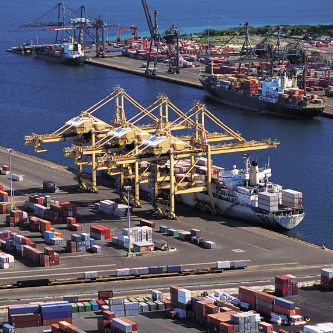
International Sea Freight - North East Asia (China) to Australia
In last month's edition we advised that Chinese New Year was fast approaching and preparations for a mini peak season were underway.
Traditionally we, as a 3PL provider and freight forwarder in Australia, see a peak in demand as we approach this special time of year where holidays are imposed. These holidays can extend beyond the traditional one week allowance that is given between 18 - 24 February, as manufacturing companies in China usually return to work on 25 February. This sudden surge in shipping demand has adverse effects on origin costs as well as rates where truckers in China also take advantage of this momentum to increase their rates as most shut down their operations often one week earlier. This can cause various issues as the short supply of trucker's available not only adds to the costs it can also delay suppliers who are rushing to get stock out of their factories in China before the holidays commence. This time of year in the international sea freight market is challenging for all and external factors such as weather and the cut backs in available space via the Slack Season Program (SSP) have both had a negative impact on supply chains. We will continue to utilise our close global network relationships for additional support and assistance to ensure that our customers’ deadlines are met.
Despite carriers filling their space and reporting healthy vessel utilisation, this current increased demand and shortage of supply will be short lived and we can expect that the market conditions will remain volatile. We may therefore see the spot market coming into play.
International Sea Freight - South East Asia to Australia
We mentioned last month that congestion was a major issue for some carriers in the hubs of Singapore and Port Kelang. While the backlog has cleared significantly for some, others are still struggling as external factors including weather and berthing delays which have both had an adverse effect. Our team will continue to monitor the situation closely and highlight to carriers the urgent orders for our customers in order to ensure these are prioritised for loading on respective connecting vessels.
The GRI that was announced on this trade to take effect from 1 February has once again failed to have any major traction as most carriers chose to extend existing rates. There have however been minor increases implemented of smaller increments affecting Thailand and Indonesian trade lanes. This is mainly due to rising feeder costs where carriers can no longer support the low rate levels and although minimal increases have been adopted, this trade remains very stable.
International Sea Freight - United States to Australia
The continued impact on this trade by the congestion being experienced has triggered a whirlwind of successful rate hikes in the form of GRIs. In addition, extensive delays continue so plan ahead to avoid disappointment. This month we are including an update on the ILWU/PMA negotiations and details on the delays being experienced at the major US ports.As of 5 February, the ILWU and PMA continue their negotiations. Earlier this month the PMA presented the ILWU with a complete contract proposal which included all the terms that had been tentatively agreed upon over the last nine months between the two parties. In addition, the PMA advised the ILWU that this was a complete offer for their consideration. At this time, the ILWU has the package in front of them and it's now up to the ILWU to determine whether they will accept the offer.
The overall situation with West Coast labour, as well as truck and chassis concerns continue to significantly challenge terminal operations. With this being stated however, there has been some real positive progress in most carriers’ efforts and ability to keep down the dwell times of units coming off the vessel and loading to the next available departure train.
With the congestion and labour constraints at all West Coast ports, there continues to be a domino effect on the local store door drayage moves. At this time, a number of drayage vendors are advising 4 to 5 day delays in making deliveries. Most carriers are working to try and advance the movement of these deliveries, but with limited power this is still a challenge, however some progress is being made.
One of our valued carrier partners provided us with a port summary as per below as to how they will continue to work with all concerned parties to ensure the best possible outcomes given the current challenging market conditions.
Oakland: The Oakland UP Terminals continues to remain congested, and we are still encountering the possibility of some delays at the UP Rail in Oakland due to the significant number of steamship lines that are omitting Oakland and routing their traffic to Long Beach. We are asking the trucking community to help work through these challenges as we evaluate the situation and try to keep everything as fluid as possible.
Tacoma: The overall situation in the PNW continues to be associated with slow port operations, along with some congestion on the rail. While there have been some rail improvements in this area during the past several weeks, there is work to be done to bring the PNW back to the original service level. Truck power in the area has improved slightly over the past couple of weeks, and currently we are seeing 3 to 4 day delays in appointments being made.
Vancouver: Congestion in Vancouver continues, and we are experiencing 5 plus day delays for a large portion of our rail traffic moving through the Vancouver area. The CP continues to work through the significant back log of dwelling units as quickly as possible. The local and national staff continues to monitor the traffic and bring all long standing units to the Terminal and CP's attention.
Inland facilities in the Midwest and Ohio region: Both of these areas are facing congestion issues at the terminals. Import cargo that arrived over the past weekend is slowly being picked up and empties returned. The weather in the Chicago region is hindering the movement of over the road moves through Northern Indiana due to lake effect snow. This is duplicated in Northern Ohio as well, that region has had some heavy snow and temperatures are expected to plummet over the next few days. Due to this weather, we are being advised that local moves are being delayed by 36 to 48 hours at a minimum. Please also note that the UP Rail facilities in Chicago are still recovering from this past weekend's blizzard that dumped 10 to 16 inches of snow at a number of local terminals. At this time, the availability from once a shipment arrives in Chicago till it become available is at least 48 hours.
Savannah: Operations at the port have improved in the past couple of weeks, but we are still experiencing vessel delays that are associated with the number of additional vessels calling the East Coast at this time. The trucking situation has improved slightly and we are now only facing a limited shortage of power in this area.
Norfolk: The Port of Virginia has improved, but this seems to be temporary at best. While progress is being made, we are still receiving word from a number of vendors that some drivers can be held up for hours due to operational constraints at the port during peak times. Truckers are advising that units are being delayed by 48 hours from the time appointments are made.
Wilmington: For the first time Wilmington has encountered delays due to the overall volume of containers that have arrived in the past few weeks. The port is working on addressing alternative gate operations which will help, but additional truck power is needed in this area to help keep the terminal as fluid as possible.
Charleston: Like Wilmington, Charleston is also experiencing a surge in traffic, however the Port of Charleston has been able to keeping cargo moving by working closely with the trucking community.
New York: New York is reporting significant congestion as the result of the snow and ice received over this past weekend. The Maher terminal is working to keep the gates as fluid as possible; however, we are hearing forecasts of further snow and icy conditions. At this time we are anticipating 24 to 48 hour delays in setting up appointments.
International Sea Freight - Europe to Australia
This trade continues to remain stable with no planned changes to rates. We continue to see BAF changes where carriers are adjusting their bunkers in line with the oil prices and this will continue to fluctuate on a monthly basis. The option to go back to transhipment services is also back in demand as orders are less urgent and the need for offshore floating warehouses is common as warehouse space continues to challenge the market.
Bunker Adjustment Factor
All trades are reporting to freight forwarding companies revisions to the bunker adjustment factor known as (BAF) due to the reduction in oil prices. As most carriers adopt an all-inclusive policy this will now allow their revenue base rate stream to be positive instead of negative as has been the case in recent times. Each carrier will update their respective trade lanes accordingly in line with the changes and will report as and when changes are to take place.
BCR is a 3PL company that provides international freight forwarding and contract logistics solutions to Australian companies and multinationals. If you are unhappy with your current freight forwarding company or 3PL provider, or feel that you can do better (and you can), contact us today for a free consultation.


